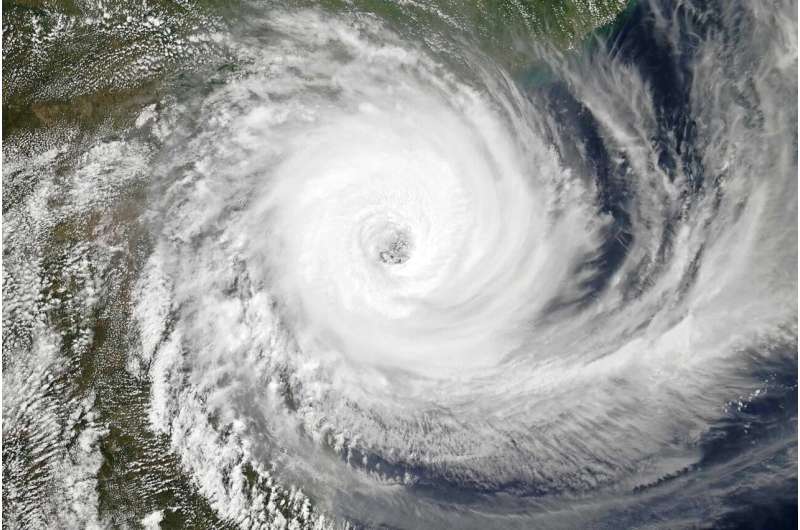This article has been reviewed according to Science X's editorial process and policies. Editors have highlighted the following attributes while ensuring the content's credibility:
fact-checked
peer-reviewed publication
trusted source
proofread
Natural coasts protect against tropical cyclones, but this protection is declining: Study

People living on the in low-lying coastal areas will be at even greater risk from cyclones in the future. Natural ecosystems offer protection, but this protection has decreased in recent years and is expected to continue to decline. This is a finding of a model study by an international team of researchers led by ETH Zurich.
Idai was one of the worst tropical cyclones to ever hit Africa and the Southern Hemisphere. The long-lasting storm caused catastrophic damage and a humanitarian crisis in Mozambique, Zimbabwe, and Malawi in 2019. More than 1,500 people lost their lives, and many more went missing. As the climate continues to change, such storms will (probably) become stronger. However, the past, present and future relationship between coastal communities and the natural protective ecosystems around them is not known.
In a model study, ETH researchers investigated the following questions: How many people are currently threatened by tropical cyclones, and how many benefit from the protective services of natural coastal habitats such as mangrove forests, reefs or salt marshes? How many people will be at risk in the future as temperatures continue to rise, and how many could be protected through habitat restoration?
According to model calculations just published in the journal Environmental Research Letters, an annual average of 67 million people living in low-lying coastal areas worldwide are currently at risk from cyclones. The greatest number of these people (in absolute terms) are in China, where 40 million people are at risk each year. Many coastal residents in Japan and the Philippines are also at risk from cyclones, with 11 and 9 million people respectively threatened per year.
If climate change continues, the number of people in coastal communities at risk from cyclones in all regions could increase by 40% to an annual average of nearly 94 million by 2050. In absolute terms, that is 27.3 million more people per year than today. These calculations do not include population growth or rising sea levels.
Natural protection crumbling away
Natural coastal habitats such as mangrove forests, reefs, seagrass or salt marshes can protect people living near them from tropical cyclones by breaking tidal waves, slowing wind gusts, or absorbing floodwaters like a retention reservoir.
This protection currently benefits 21% of people at risk of cyclones. However, the level of protection varies greatly from region to region: in the Virgin Islands in the Caribbean, 92% of people living in the danger zone are protected by natural shorelines, while in Vietnam the figure is just 11%.
In addition, the protective effect has decreased over the past 30 years. Today, 1.4 million more people are unprotected and at risk from cyclones each year than in 1992. This is mainly due to the destruction of ecosystems. The researchers estimate that protection by natural coasts will continue to decline until 2050.
"At the same time, population density has increased along coastlines in recent decades, and more so along stretches where protective ecosystems are no longer present," points out Sarah Hülsen, the study's lead author. "That is a worrisome development."
Another factor in reduced protection relates to how climate change is expected to alter the occurrence of cyclones: in the future, these will appear in places where they weren't expected even just a few years ago.
Time to protect the protection
"This makes it immensely important to protect existing intact coastal habitats," says Chahan M. Kropf, co-author of the study. It is also important to restore lost habitats, for example by planting mangroves.
The potential to offer people better protection against cyclones by restoring mangrove forests is especially great in island states in the Caribbean (like Bermuda or Trinidad and Tobago) and in the Pacific (like Papua New Guinea). In Bermuda, two-fifths of those at risk from cyclones would benefit from such measures.
"However, the benefits provided by restored habitats are often less than those provided by natural habitats. That means protection takes priority over restoration," Kropf says.
The study provides a basis for planning restoration initiatives and adaptations to climate change by highlighting, in the context of climate change, which regions are central to how coastal areas offer protection.
More information: Sarah Hülsen et al, Global protection from tropical cyclones by coastal ecosystems—past, present, and under climate change, Environmental Research Letters (2023). DOI: 10.1088/1748-9326/ad00cd
Journal information: Environmental Research Letters
Provided by ETH Zurich




















